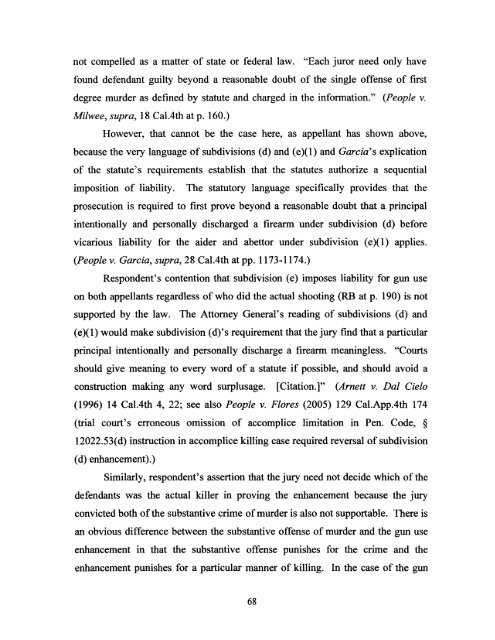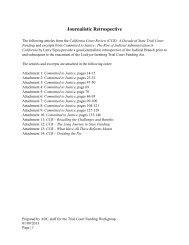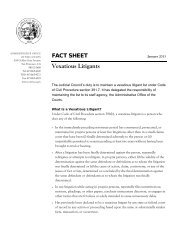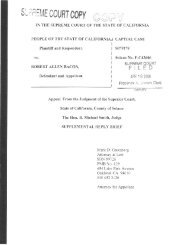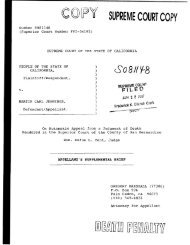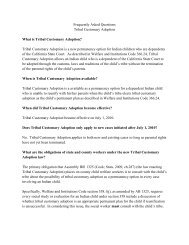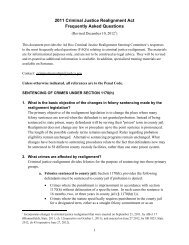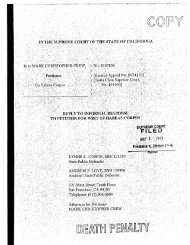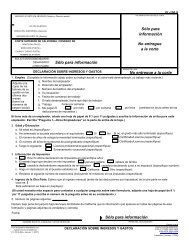Appellant, William Satele, Reply Brief - California Courts - State of ...
Appellant, William Satele, Reply Brief - California Courts - State of ...
Appellant, William Satele, Reply Brief - California Courts - State of ...
You also want an ePaper? Increase the reach of your titles
YUMPU automatically turns print PDFs into web optimized ePapers that Google loves.
not compelled as a matter <strong>of</strong> state or federal law. "Each juror need only have<br />
found defendant guilty beyond a reasonable doubt <strong>of</strong> the single <strong>of</strong>fense <strong>of</strong> first<br />
degree murder as defined by statute and charged in the information." (People v.<br />
Milwee, supra, 18 Ca1.4th at p. 160.)<br />
However, that cannot be the case here, as appellant has shown above,<br />
because the very language <strong>of</strong> subdivisions (d) and (e)(I) and Garcia's explication<br />
<strong>of</strong> the statute's requirements establish that the statutes authorize a sequential<br />
imposition <strong>of</strong> liability. The statutory language specifically provides that the<br />
prosecution is required to first prove beyond a reasonable doubt that a principal<br />
intentionally and personally discharged a firearm under subdivision (d) before<br />
vicarious liability for the aider and abettor under subdivision (e)(1) applies.<br />
(People v. Garcia, supra, 28 Ca1.4th at pp. 1173-1174.)<br />
Respondent's contention that subdivision (e) imposes liability for gun use<br />
on both appellants regardless <strong>of</strong>who did the actual shooting (RB at p. 190) is not<br />
supported by the law. The Attorney General's reading <strong>of</strong> subdivisions (d) and<br />
(e)(1) would make subdivision (d)'s requirement that the jury find that a particular<br />
principal intentionally and personally discharge a firearm meaningless. "<strong>Courts</strong><br />
should give meaning to every word <strong>of</strong> a statute if possible, and should avoid a<br />
construction making any word surplusage. [Citation.]" (Arnett v. Dal Cielo<br />
(1996) 14 Ca1.4th 4, 22; see also People v. Flores (2005) 129 Cal.AppAth 174<br />
(trial court's erroneous omission <strong>of</strong> accomplice limitation in Pen. Code, §<br />
12022.53(d) instruction in accomplice killing case required reversal <strong>of</strong>subdivision<br />
(d) enhancement).)<br />
Similarly, respondent's assertion that the jury need not decide which <strong>of</strong>the<br />
defendants was the actual killer in proving the enhancement because the jury<br />
convicted both <strong>of</strong>the substantive crime <strong>of</strong>murder is also not supportable. There is<br />
an obvious difference between the substantive <strong>of</strong>fense <strong>of</strong> murder and the gun use<br />
enhancement in that the substantive <strong>of</strong>fense punishes for the crime and the<br />
enhancement punishes for a particular manner <strong>of</strong> killing. In the case <strong>of</strong> the gun<br />
68


